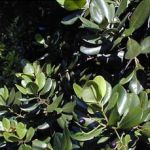| Common Name: |
West Indian Bay |
| Other Names: |
Bay Rum Tree |
| Botanical Name: |
Pimenta racemosa syn. P. acris |
| Genus: |
Pimenta |
| Family: |
Myrtaceae |
| Native Location: |
West Indies, Venezuela, and the Guianas. |
| Cultivation: |
Rich, well-drained, sandy soil in sun. |
| Propagation: |
By seed sown when ripe; semi-ripe cuttings in summer. |
| Harvest: |
Leaves are picked as required and used fresh for infusions. Fruits are collected when fully grown, but unripe and green, and distilled for oil, or dried for liquid extracts and powders; they turn black when dried. Bark is removed from prunings, dried and ground. |
| Height: |
14m (42ft) |
| Width: |
5m (15ft) |
| Hardiness: |
Min. 15-18°C (59-64°F) |
| Parts Used: |
Bark, Fruits, Leaves, Oil. |
| Properties: |
An astringent, antiseptic, aromatic herb with rubefacient effects when applied externally. |
| Medicinal Uses: |
Internally, as a tea for chills. Externally for muscular aches and pains, rheumatism, neuralgia, greasy hair, dandruff, and hair loss. |
| Culinary Uses: |
Barks and fruits are used for flavoring in the Carribean, notably in blaff (fish broth). |
| Economic Uses: |
Oil and extracts are used for flavoring in the food industry. |
| Bibliography: |
Encyclopedia of Medicinal Herbs by Joseph Kadans, N.D., Ph.D. Copyright © 1970 Parker Publishing Company, Inc. pg 29
The Encyclopedia of Herbs by Deni Bown Copyright © 1995, 2001 Dorling Kindersley Limited pp 316-317
|

